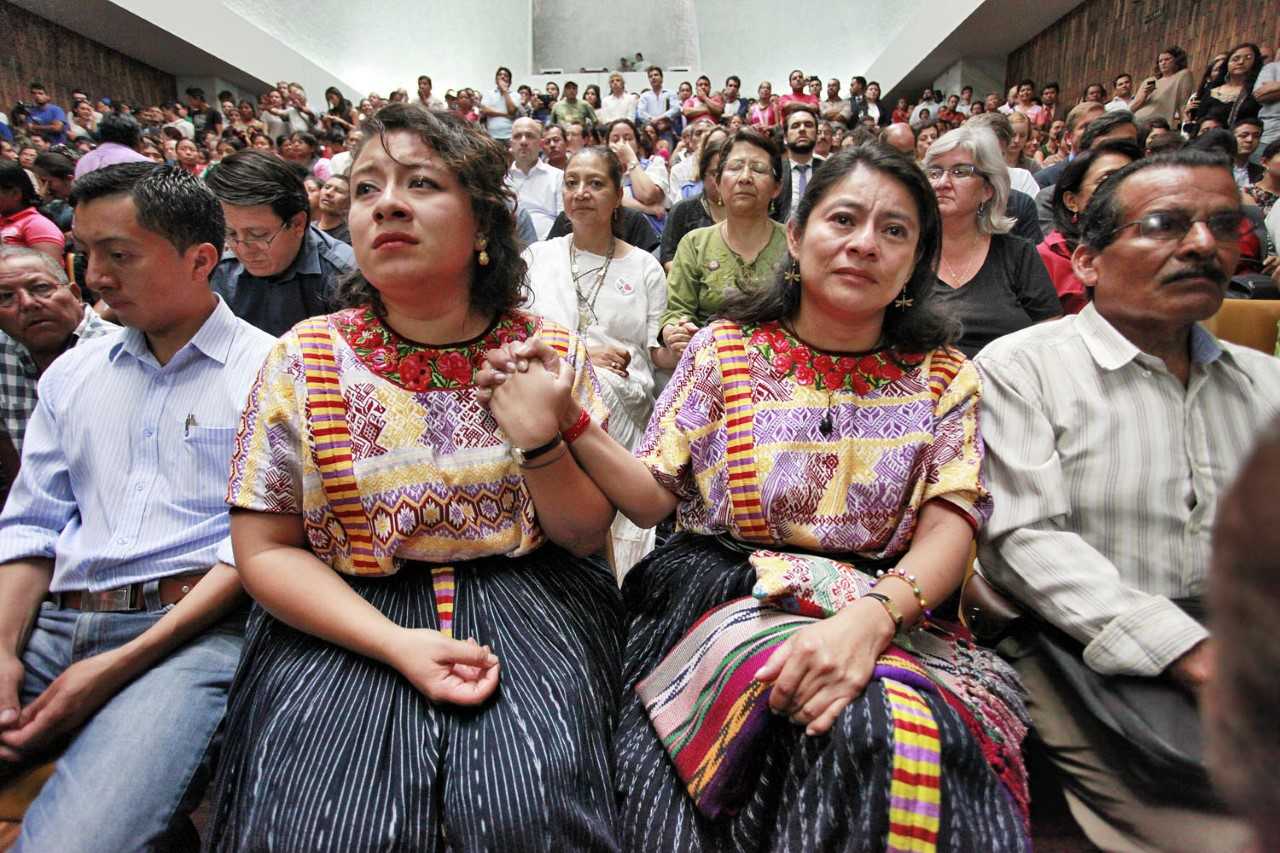Filmmaker to give full footage of genocide trial in Guatemala to USC Shoah Foundation

 Irma Alicia Velásquez Nimatuj (right) watches the Ríos Montt genocide trial with her daughter Maria Aguilar. Photo by Daniel Hernández-Salazar / "500 YEARS"
Irma Alicia Velásquez Nimatuj (right) watches the Ríos Montt genocide trial with her daughter Maria Aguilar. Photo by Daniel Hernández-Salazar / "500 YEARS" Even so, the dictator at the helm – General Efraín Ríos Montt – granted an interview to a young filmmaker named Pamela Yates.
In the interview, Ríos Montt boasted that he was in complete control of his armed forces.
“If I can’t control the Army, than what am I doing here?” he asks in the interview.
More than 30 years later, an elderly Ríos Montt sat in a courtroom and watched as the interview of his younger self undermined his argument that the army carrying out massacres in rural villages had gone rogue.
Footage of this courtroom drama and other moments of the historic 2013 trial against Ríos Montt features prominently in "500 Years," the third in a trilogy of documentaries about the Guatemala genocide directed by Yates.
Last week, after a screening of the 2017 film at USC, Yates and her husband, Paco de Onís – the film’s executive producer – said they plan to give a copy of their footage of the Ríos Montt trial to USC Shoah Foundation.
“We’d be honored to have the material here” at the Institute, said Yates, who won a Sundance Award in 1983 for the first film in the series, “When the Mountains Tremble.” “It would be accessible to the world, and it would be preserved.” And it would help future scholars understand the causes and warning signs of genocide, de Onís added.
The film of the genocide trial from Guatemala will complement two major holdings already housed in the Holocaust and Genocide Collection at USC Libraries. One collection contains the original transcripts of the Nuremberg trials; only a dozen original copies exist worldwide. The 300 boxes of Nuremberg documents include transcripts for the major war crimes trial and the 12 follow-up trials against German perpetrator institutions. The second major collection contains 50 boxes of materials from the class-action lawsuit against New York Life Insurance regarding the Armenian Genocide.
“Beyond the exciting comparative potential of the Guatemalan trial footage, scholars will be able to combine their research with the unique trial material with testimonies from the USC Shoah Foundation Visual History Archive to advance the study of the actual experiences of those affected most by the genocide,” said Wolf Gruner, founding director of the USC Shoah Foundation Center for Advanced Genocide Research.
 Ex General Efrain Rios Montt testifying during the trial. Photo: Elena Hermosa.
Ex General Efrain Rios Montt testifying during the trial. Photo: Elena Hermosa.Yates’ interview of Ríos Montt – who died earlier this month – turned out to be among several pieces of critical evidence that led to his 2013 conviction of genocide. (So did forensic evidence produced by La Fundación de Antropología Forense de Guatemala [FAFG], a USC Shoah Foundation partner.)
“500 Years” uses the Ríos Montt trial as a jumping-off point to chart the recent rise of indigenous resistance in Guatemala, which has taken the form of courtroom testimony, public demonstrations and civil disobedience. The awakening follows five centuries of marginalization dating back to the arrival of the first Spanish colonists. The film features several dramatic courtroom scenes in which Mayan witnesses – cloaked in brightly colored traditional garb –recall what happened to them and their family members as, a few feet away, Ríos Montt and his brigade of lawyers look stonily on.
Although only a handful of witnesses were included in the film, Yates’s cameras captured the entire trial, which became a landmark in human-rights law with the conviction of Ríos Montt, the first former head of state to be found guilty of genocide in his or her own country. (The conviction was overturned on a technicality, and Ríos Montt was being retried at the time of his death on April 1 at age 91. He spent his final six years under house arrest until he passed away.)
During the trial, nearly 100 Maya testified about the mass killings, rapes, forced disappearances and village burnings that characterized the atrocities. If added to the Visual History Archive, their testimonies would sit alongside others from the same trial by military experts, academics and Ríos Montt himself, who declared during his 40 minutes on the stand: “I never did it.”
Yates and de Onís know of only one other videotaped recording of the complete trial, taken by the Attorney General of Guatemala. They add that the Guatemalan courts don’t produce transcripts of their trials.
“We probably have the only complete record outside of Guatemala,” Yates said. Added de Onís: “With all the hostility that there is to the people in the justice system, I would worry about the record of the trial being destroyed.”
“500 Years” also highlights the efforts of a new generation of indigenous activists, who have helped organize protests in opposition to the extractive industries under control of transnational companies.
In addition, the documentary traces the fall of former president Otto Pérez Molina, who in 2015 was indicted and imprisoned without bail on corruption charges. (Molina served as a colonel under Ríos Montt during the genocide and has also been accused of ordering atrocities.)
Guatemala remains a dangerous country to challenge corruption; four journalists were killed there in 2017, and 98 were attacked, according to the International News Safety Institute.
Irma Alicia Velásquez Nimatuj, a journalist and indigenous-rights activist who is featured in the film, said she regularly leaves the country for her safety.
“I need to use my sixth sense,” said Nimatuj, who was also in Los Angeles last week for a screening of “500 Years.”
As for the late Ríos Montt, Yates didn’t use his incriminating words until the second installment of her trilogy, the 2011 film “Granito: How to Nail a Dictator.” She repurposed it for “500 Years.”
“That’s not material that appeared in the original film,” she said. “It was only when I went back to look through the outtakes – because the lawyers asked me to look through all my footage – I found the original uncut interview. And it was in that that I found the command responsibility part.”
Ríos Montt, she said, was surprisingly easy to access in 1982. “I just asked,” she said, noting that, at the time, the mainstream media was more interested in conflicts raging in other Latin American countries, such as El Salvador and Nicaragua. Rios Montt likely saw her request as an opportunity to show the world his efforts to suppress communism.
“He was confident, arrogant,” Yates remembers. “He saw me as a gringita … he saw me as a girl. I wasn’t a threat to him.”